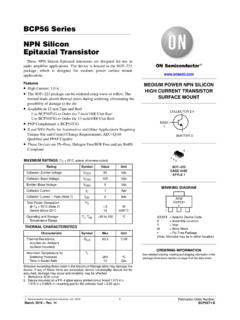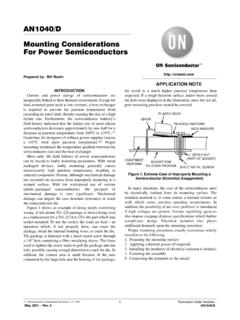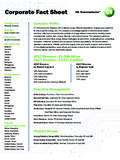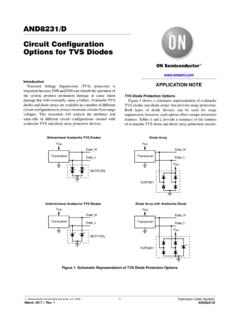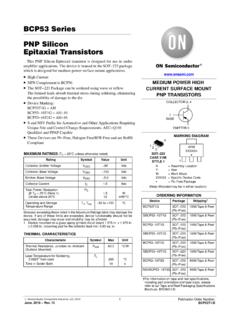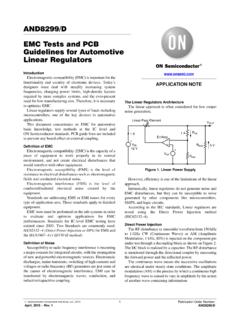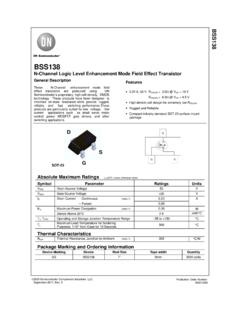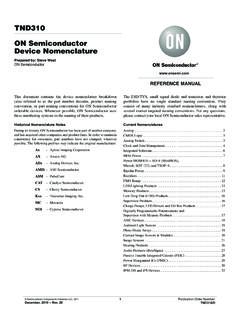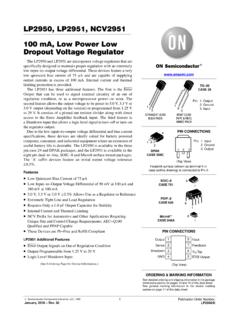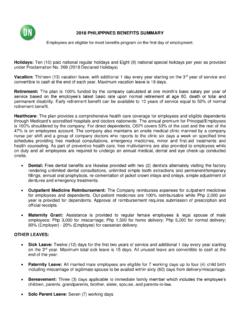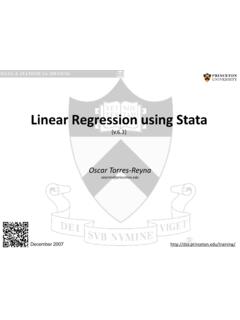Transcription of LM2596 3.0 A, Step-Down Switching Regulator
1 Semiconductor Components Industries, LLC, 2008 November, 2008 Rev. 01 Publication Order Number: LM2596 A, Step-Down SwitchingRegulatorThe LM2596 Regulator is monolithic integrated circuit ideally suitedfor easy and convenient design of a step down Switching Regulator (buck converter). It is capable of driving a A load with excellentline and load regulation. This device is available in adjustable outputversion and it is internally compensated to minimize the number ofexternal components to simplify the power supply LM2596 converter is a switch mode power supply, itsefficiency is significantly higher in comparison with popularthree terminal linear regulators , especially with higher input LM2596 operates at a Switching frequency of 150 kHz thusallowing smaller sized filter components than what would be neededwith lower frequency Switching regulators . Available in a standard5 lead TO 220 package with several different lead bend options, andD2 PAK surface mount other features include a guaranteed $4% tolerance on outputvoltage within specified input voltages and output load conditions, and$15% on the oscillator frequency.
2 External shutdown is included,featuring 80 mA (typical) standby current. Self protection featuresinclude switch cycle by cycle current limit for the output switch, aswell as thermal shutdown for complete protection under Adjustable Output Voltage Range V 37 V Guaranteed A Output Load Current Wide Input Voltage Range up to 40 V 150 kHz Fixed Frequency Internal Oscillator TTL Shutdown Capability Low Power Standby Mode, typ 80 mA Thermal Shutdown and Current Limit Protection Internal Loop Compensation Moisture Sensitivity Level (MSL) Equals 1 Pb Free Packages are AvailableApplications Simple High Efficiency step down (Buck) Regulator Efficient Pre Regulator for Linear regulators On Card Switching regulators Positive to Negative Converter (Buck Boost) Negative step Up Converters Power Supply for Battery ChargersSee detailed ordering and shipping information in the packagedimensions section on page 23 of this data INFORMATION15TO 220TV SUFFIXCASE 314B15 Heatsink surface connected to Pin 3TO 220T SUFFIXCASE 314 DPin1.
3 Vin2. Output3. Ground4. Feedback5. ON/OFFD2 PAKD2T SUFFIXCASE 936 AHeatsink surface (shown as terminal 6 incase outline drawing) is connected to Pin 315 general marking information in the device markingsection on page 23 of this data MARKING INFORMATIONLM2596 1. Typical Application and Internal Block Diagram12 VUnregulated DC InputL133 mHGND+Vin1 Cin100 mF3ON/OFF5 Output2 Feedback4D11N5822 Cout220 mFTypical Application (Adjustable Output Voltage Version)Block DiagramUnregulatedDC Input+Vin1 CoutFeedback4 CinL1D1R2R1 Output2 GND3ON/OFF5 ResetLatchThermalShutdown150 VBand-GapReferenceFreqShift30 kHzComparatorFixed GainError V V Regulated Output A RATINGSR atingSymbolValueUnitMaximum Supply VoltageVin45 VON/OFF Pin Input Voltage V V +VinVOutput Voltage to Ground (Steady State) DissipationCase 314B and 314D (TO 220, 5 Lead)PDInternally LimitedWThermal Resistance, Junction to AmbientRqJA65 C/WThermal Resistance, Junction to C/WCase 936A (D2 PAK)PDInternally LimitedWThermal Resistance, Junction to AmbientRqJA70 C/WThermal Resistance, Junction to C/WStorage Temperature RangeTstg 65 to +150 CMinimum ESD Rating (Human Body Model.)
4 C = 100 pF, R = kW) Temperature (Soldering, 10 seconds) 260 CMaximum Junction TemperatureTJ150 CStresses exceeding Maximum Ratings may damage the device. Maximum Ratings are stress ratings only. Functional operation above theRecommended Operating Conditions is not implied. Extended exposure to stresses above the Recommended Operating Conditions may affectdevice FUNCTION DESCRIPTIONPinSymbolDescription (Refer to Figure 1)1 VinThis pin is the positive input supply for the LM2596 step down Switching Regulator . In order to minimize voltage transi-ents and to supply the Switching currents needed by the Regulator , a suitable input bypass capacitor must be present(Cin in Figure 1).2 OutputThis is the emitter of the internal switch. The saturation voltage Vsat of this output switch is typically V. It should bekept in mind that the PCB area connected to this pin should be kept to a minimum in order to minimize coupling tosensitive ground pin. See the information about the printed circuit board pin is the direct input of the error amplifier and the resistor network R2, R1 is connected externally to allow pro-gramming of the output allows the Switching Regulator circuit to be shut down using logic level signals, thus dropping the total input supplycurrent to approximately 80 mA.
5 The threshold voltage is typically V. Applying a voltage above this value (up to+Vin) shuts the Regulator off. If the voltage applied to this pin is lower than V or if this pin is left open, the regulatorwill be in the on RATINGS (Operating Ratings indicate conditions for which the device is intended to be functional, but do not guaranteespecific performance limits. For guaranteed specifications and test conditions, see the Electrical Characteristics.)RatingSymbolValueUnitOp erating Junction Temperature RangeTJ 40 to +125 CSupply to 40 VLM2596 PARAMETERSELECTRICAL CHARACTERISTICS Specifications with standard type face are for TJ = 25 C, and those with boldface type applyover full Operating Temperature Range 40 C to +125 CCharacteristicsSymbolMinTypMaxUnitLM259 6 (Note 1, Test Circuit Figure 15)Feedback Voltage (Vin = 12 V, ILoad = A, Vout = V, ) Voltage ( V Vin 40 V, A ILoad A, Vout = V) (Vin = 12 V, ILoad = A, Vout = V) 73 %CharacteristicsSymbolMinTypMaxUnitFeedb ack Bias Current (Vout = V)Ib25100200nAOscillator Frequency (Note 2)fosc135120150165180kHzSaturation Voltage (Iout = A, Notes 3 and 4) Duty Cycle ON (Note 4)DC95%Current Limit (Peak Current, Notes 2 and 3) Leakage Current (Notes 5 and 6)Output = 0 VOutput = Current (Note 5) Quiescent Current (ON/OFF Pin = V ( OFF ))(Note 6)Istby80200250mAON/OFF PIN LOGIC INPUTT hreshold = 0 V ( Regulator OFF)
6 = Nominal Output Voltage ( Regulator ON) Pin Input CurrentON/OFF Pin = V ( Regulator OFF)IIH 1530mAON/OFF Pin = 0 V ( Regulator ON)IIL External components such as the catch diode, inductor, input and output capacitors can affect Switching Regulator system the LM2596 is used as shown in the Figure 15 test circuit, system performance will be as shown in system parameters The oscillator frequency reduces to approximately 30 kHz in the event of an output short or an overload which causes the regulated outputvoltage to drop approximately 40% from the nominal output voltage. This self protection feature lowers the average dissipation of the IC bylowering the minimum duty cycle from 5% down to approximately 2%.3. No diode, inductor or capacitor connected to output (Pin 2) sourcing the Feedback (Pin 4) removed from output and connected to 0 Feedback (Pin 4) removed from output and connected to +12 V to force the output transistor off .6. Vin = 40 , QUIESCENT CURRENT (mA)40 TYPICAL PERFORMANCE CHARACTERISTICS (Circuit of Figure 15)Vout, OUTPUT VOLTAGE CHANGE (%)Vout, OUTPUT VOLTAGE CHANGE (%), STANDBY QUIESCENT CURRENT (TJ, JUNCTION TEMPERATURE ( C)IO, OUTPUT CURRENT (A)TJ, JUNCTION TEMPERATURE ( C)Vin, INPUT VOLTAGE (V)Vin, INPUT VOLTAGE (V)INPUT - OUTPUT DIFFERENTIAL (V)TJ, JUNCTION TEMPERATURE ( C)Figure 2.)
7 Normalized Output VoltageTJ, JUNCTION TEMPERATURE ( C)Figure 3. Line RegulationFigure 4. Dropout VoltageFigure 5. Current LimitFigure 6. Quiescent CurrentFigure 7. Standby Quiescent CurrentILoad = 200 mAILoad = AVin = 12 VVin = 40 VL1 = 33 mHRind = WILoad = 500 mAILoad = AVout = VMeasured atGround PinTJ = 25 CVON/OFF = V A) = 20 VILoad = 500 mANormalized at TJ = 25 CILoad = 500 mATJ = 25 V and V12 V and 15 VIstbyVin = 25 VLM2596 , SATURATION VOLTAGE (V) , FEEDBACK PIN CURRENT (nA), STANDBY QUIESCENT CURRENT ( A)Istby, INPUT VOLTAGE (V)TJ, JUNCTION TEMPERATURE ( C)SWITCH CURRENT (A)NORMALIZED FREQUENCY (%)TJ, JUNCTION TEMPERATURE ( C)Figure 8. Standby Quiescent CurrentVin, INPUT VOLTAGE (V)Figure 9. Switch Saturation VoltageFigure 10. Switching FrequencyFigure 11. Minimum Supply Operating VoltageFigure 12. Feedback Pin CurrentTJ = 25 , JUNCTION TEMPERATURE ( C) C25 C125 CVout ' VILoad = 500 mATYPICAL PERFORMANCE CHARACTERISTICS (Circuit of Figure 15)Vin 50 250255075100125 VIN = 12 V Normalizedat 25 CLM2596 A00 ABC100 ms/div2 ms/divFigure 13.
8 Switching WaveformsFigure 14. Load Transient ResponseVout = 5 VA: Output Pin Voltage, 10 V/divB: Switch Current, A/divC: Inductor Current, A/div, AC CoupledD: Output Ripple Voltage, 50 mV/div, AC CoupledHorizontal Time Base: ms/div10 A100 A- 100 mVLoadCurrentTYPICAL PERFORMANCE CHARACTERISTICS (Circuit of Figure 15)DFigure 15. Typical Test CircuitD11N5822L133 mHOutput24 FeedbackCout220 mFCin100 mFLM2596153ON/OFFGNDVinLoadVout5,000 VAdjustable Output Voltage VersionsVout+Vref ) R2R1 R2+R1 VoutVref Where Vref = V, R1 between k and V - 40 VUnregulatedDC InputCFFLM2596 LAYOUT GUIDELINESAs in any Switching Regulator , the layout of the printedcircuit board is very important. Rapidly Switching currentsassociated with wiring inductance, stray capacitance andparasitic inductance of the printed circuit board traces cangenerate voltage transients which can generateelectromagnetic interferences (EMI) and affect the desiredoperation.
9 As indicated in the Figure 15, to minimizeinductance and ground loops, the length of the leadsindicated by heavy lines should be kept as short as best results, single point grounding (as indicated) orground plane construction should be the other hand, the PCB area connected to the Pin 2(emitter of the internal switch) of the LM2596 should bekept to a minimum in order to minimize coupling to sensitive part of the circuit is the feedback. It isimportant to keep the sensitive feedback wiring short. Toassure this, physically locate the programming resistors nearto the Regulator , when using the adjustable version of theLM2596 PROCEDUREBuck Converter BasicsThe LM2596 is a Buck or step down Converter whichis the most elementary forward mode converter. Its basicschematic can be seen in Figure operation of this Regulator topology has two distincttime periods. The first one occurs when the series switch ison, the input voltage is connected to the input of the output of the inductor is the output voltage, and therectifier (or catch diode) is reverse biased.
10 During thisperiod, since there is a constant voltage source connectedacross the inductor, the inductor current begins to linearlyramp upwards, as described by the following equation:IL(on)+ VIN*VOUT tonLDuring this on period, energy is stored within the corematerial in the form of magnetic flux. If the inductor isproperly designed, there is sufficient energy stored to carrythe requirements of the load during the off 16. Basic Buck ConverterDVinRLoadLCoutPowerSwitchThe next period is the off period of the power the power switch turns off, the voltage across theinductor reverses its polarity and is clamped at one diodevoltage drop below ground by the catch diode. The currentnow flows through the catch diode thus maintaining the loadcurrent loop. This removes the stored energy from theinductor. The inductor current during this time is:IL(off)+ VOUT*VD toffLThis period ends when the power switch is once againturned on.
